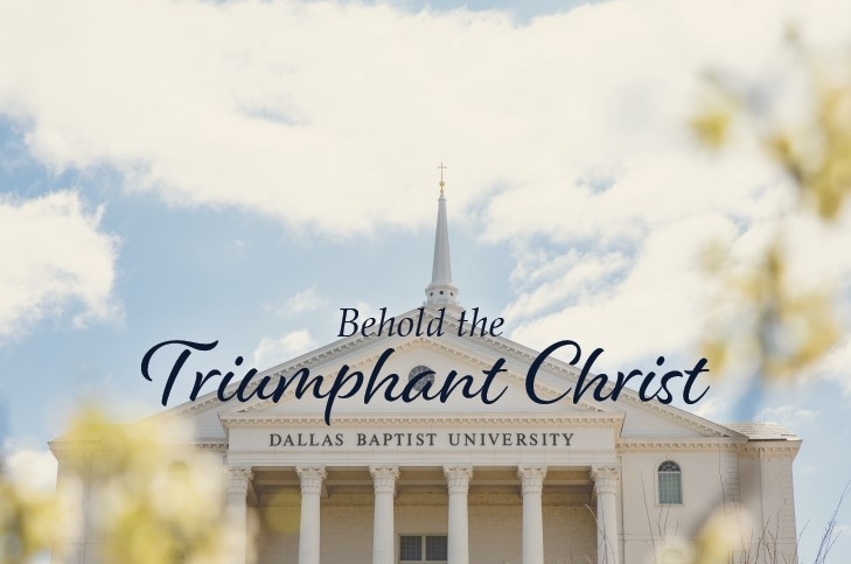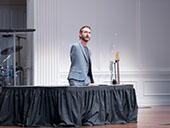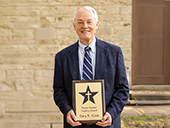Anticipating Christ’s Second Triumphal Entry by Recalling His First
This article is over six months old and may reference former titles for DBU faculty or staff, discontinued programs, or other details that have since changed. If you have any questions, please contact us at news@dbu.edu, or (214) 333-5172.

Stories are only effective when read from beginning to end.
No reader can grasp the gravity of failure or relief of rescue with only partial information—at least not at full scale. Empathy and awe draw upon contrast from what was to what is. This is the nature of all stories.
But what if you are a character in the story – a story with four parts? You are living in Part 3. It is time for your annual reflection on Part 2. The world of part 1 is unfamiliar to you. There is a promise of Part 4, but the author has yet to deliver, as only He can.
This is the state of modern-day Christians during Passion Week, notably the most important week in human history. The week begins with Palm Sunday, Part 2, but without knowing Part 1, the drama surrounding a man riding into town on a donkey can only mean so much. First, let's do a quick recap.
Part One
In the beginning, there was nothing, and then God spoke a world full of life into motion. It was perfect. One man. One woman. One rule which was broken, rendering this world no longer perfect.
As with any design, elements work together to produce a full product. The same is true with machines. A part of the machine attempting to play an unintended role will render the entire system incapable of reaching its full potential. A part simply unable to maintain its responsibilities will do the same.
So went the story of man, rebelling against its design and Maker.
From the first moment of sin, humanity inflicted upon itself a life of injustice, sickness, and oppression. The design needed restoration. Man’s evil was so great that God sent a flood. None survived except one righteous man and his family. Noah, by faith, built an ark trusting in what was unseen.
After the flood appeared a rainbow, the first of four promises initiated by God to redeem the world and usher humanity back to a life of flourishing as originally designed. The promises came in the form of covenants, a two-party agreement of partnership.
God promised Noah that humanity would never again face such a flood. Restoration would come another way.
Generations passed until a man named Abraham was chosen by God and promised blessings, land, and flourishing for his family and descendants. Ultimately, this blessing would extend to all people. In return, the tribes of Israel were to walk with God—their part of the covenant.
Yet the journey took a route unforeseen by Abraham's decendents through the suffering of slavery in Egypt. From the line of Abraham, a man named Moses was chosen by God to lead His people out of slavery. Once rescued, God brought them into the promised land. In covenant, Israel was to keep a set of laws intended to provide boundaries for life that would maximize flourishing.
Israel rebelled. Evil reigned.
Exiled from the Promised Land, God’s people lived in oppression under evil kings and rulers. Injustice upon injustice. A fourth covenant was given by God, promising that a man from the line of King David would reign. This king would bring the promises of land, descendants, and blessing. Again, God called His people to walk with Him.
Israel rebelled. Evil reigned.
Part Two
One night in Bethlehem a child was born, and the world would never be the same. Immediately, His life was controversial.
He grew in stature, teaching even His elders at an early age. Entering formal ministry at around the age of 30, he demonstrated compassion for the lowly, and His manner of speaking, miraculous power to heal, and responses every question and challenge left society split in their reaction.
Some followed Him, placing themselves under His discipleship. They recognized Him as the Messiah foretold by the covenants in the first part of the story. The fulfillment of the covenants was underway.
But those most poised to receive a Savior, whose entire ancestral groan was for a king, were blind. Their fixed assumption that the Messiah would be a repeat of Moses and the Promised Land kept them unable to recognize, or perhaps accept, a Savior that came in the form of an ordinary man. This Jesus could not possibly be the one for whom they had so desperately longed.
Religious conflict was compounded by Roman power as Caesar also claimed to be the son of god. Roman rule brought civil war, injustice, fear, and idolatry of leadership. This Jesus, claiming to be the true Son of God, contradicted their king, their security, their control. For the Romans, Jesus needed to be eliminated.
It is into this atmosphere that Jesus made His triumphal entry. The day would eventually be coined Palm Sunday. The city was in conflict. A controversial man was riding into Jerusalem on a donkey. Answers to “Who do you say I Am?” varied greatly.
Jesus was coming to save, initiating a week that would provide everlasting life for believers—a week that would culminate in His torture and death on a cross.
But, praise God, three days later His grave was found empty. Death was defeated. Jesus is alive. After several days demonstrating the powerful resurrection, he ascended to the right hand of the Father.
Evil no longer reigned, even if it still remained.
Part Three
Part 3 of the story must be told in two tenses: past and present. It includes the response of Jesus’ followers after His resurrection and before His return.
Before Jesus ascended into heaven, He commanded His disciples to tell others about what they had learned. Equipped with the Holy Spirit, they were to teach and walk in His way, the way of true life.
Teaching and walking proved difficult and controversial. Immediately, the account of Christ was manipulated and construed by His enemies. So, the disciples began writing down the story of Jesus for future generations to know. The New Testament was formed.
Meanwhile, they set out on a mission to share the Gospel story. They spread out through individual missionary journeys sending letters back and forth with instruction, admonition, and encouragement as cities grew with greater numbers of believers.
This group of believers became known as the Church, constituting both a local gathering of believers as well as a global family. Through these gatherings, summaries of belief, or creeds, began to form in order to help maintain the boundaries of doctrinal understanding.
Moving forward, the Church struggled to define faithfulness, subdue sin, and respond to evolving contexts. Groups of believers split through various conflicts, many times dealing with how to interpret the Bible, what doctrines should be followed, and which traditions to maintain.
Part 3 of the story has been far from perfect. The same patterns seen in Part 1 of the story remain, with humanity as a whole rejecting their creator or many who claim to follow Christ simply failing to honor God’s covenant. The perfection anticipated in Part 4 hasn't arrived. It is still coming.
You are here. You exist between the resurrection in Part 2 and the story’s full redemption that is coming in Part 4. As has been the case since the early days of the Church, you stand alongside believers struggling to walk with God in a world that remains in conflict and continually have to decide your actions within the story.
The year is 2021. The day is Palm Sunday. The controversial Savior is entering on a donkey, and you are challenged with the same question that challenges everybody every day.
Who do you say He is?
Sources and Additional Resources
- N.T. Wright, Jesus in the Perfect Storm
- The Bible Project, Matthew
- Easter Now App
- TVC Resources, Biblical History Visual Timeline
Bailey Pylant was the Coordinator of News and Social Media for University Communications at Dallas Baptist University from 2017-2021.








